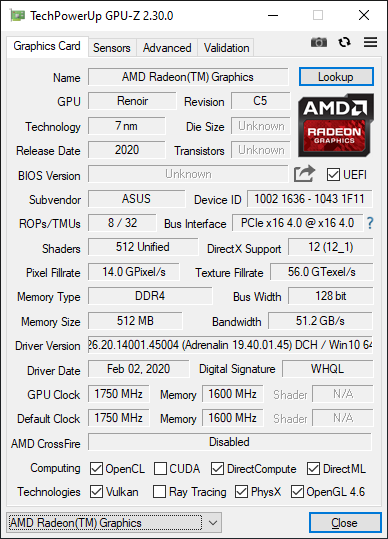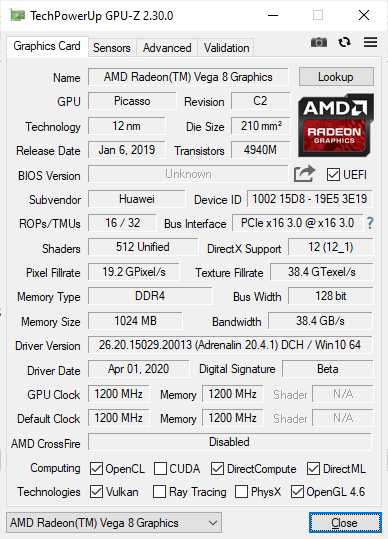AMD’s Mobile Revival: Redefining the Notebook Business with the Ryzen 9 4900HS (A Review)
by Dr. Ian Cutress on April 9, 2020 9:00 AM ESTTesting the Ryzen 9 4900HS Integrated Graphics
Under the hood of the Ryzen 9 4900HS, aside from the eight Zen 2 cores, is an enhanced Vega 8 graphics solution. For this generation of mobile processors, AMD is keeping the top number of compute units to 8, whereas in the previous generation it went up to Vega 11. Just by the name, one would assume that AMD has lowered the performance of the integrated graphics. This is not the case.
For the new Ryzen Mobile 4000 processors, the Vega graphics here are enhanced in three main ways over the previous generation. First is that it is built on the 7nm process node, and AMD put a lot of effort into physical design, allowing for a more optimized version that has a wider voltage/frequency window compared to the previous generation. Secondly, and somewhat connected, is the frequency: the new processors top out at 1750 MHz, rather than 1400 MHz, which would naturally give a simple 25 % boost with all other things being equal. Third on the list is memory, as the new platform supports up to DDR4-3200, rather than DDR4-2400, providing an immediate bandwidth boost which is what integrated graphics loves. There’s also the nature of the CPU cores themselves, having larger L3 caches, which often improves integrated graphics workloads that interact a lot with the CPU.
Normally, with the ASUS Zephryus G14, the switching between the integrated graphics and the discrete graphics should be automatic. There is a setting in the NVIDIA Control Panel to let the system auto-switch between integrated and discrete, and we would expect the system to be on the IGP when off the wall power, but on the discrete card when gaming (note, we had issues in our battery life test where the discrete card was on, but ASUS couldn’t reproduce the issue). In order to force the integrated graphics for our testing, because the NVIDIA Control Panel didn’t seem to catch all of our tests to force them onto the integrated graphics, we went into the device manager and actually disabled the NVIDIA graphics.
This left us with AMD’s best integrated graphics in its Ryzen Mobile 4000 series: 1750 MHz of enhanced Vega 8 running at DDR4-3200.

Renoir with Vega 8 – updated to 20.4 after this screenshot was taken
Our comparison point here is actually a fairly tricky one to set up. Unfortunately we do not have a Ryzen 7 3750H from the previous generation for comparison, but we do have an Honor Magicbook 14, which has a Ryzen 5 3500U.
This is a 15 W processor, running at 1200 MHz and DDR4-2400, which again makes the comparison a little tricky, but it is better than comparing it to the Intel HD630 graphics in the Razer Blade.
We also re-ran the benchmarks on the latest drivers with AMD's 65 Desktop APUs, the Ryzen 5 3400G (with Vega11) and the Ryzen 3 3200G (with Vega 8). These are running at DDR4-2933, the AMD maximum officially supported by these APUs (which means anything above this is overclocking).


This is a pretty substantial difference, no joke.



Hopefully we will get more variants of the Ryzen integrated graphics to test, along with an Ice Lake system.











267 Comments
View All Comments
Cooe - Thursday, April 9, 2020 - link
Your Cinebench R20 scores are labeled backwards lol. It's the Asus/Ryzen that scored 4394.maroon1 - Thursday, April 9, 2020 - link
How the hell Q-Max RTX 2060 beats regular 2060 in 2 out of the 4 games ?? This does not sound like GPU-bond test. You should test borderland 3 and FFXV in higher setting.yeeeeman - Thursday, April 9, 2020 - link
Higher clock speeds, more cores, higher ipc.Irata - Friday, April 10, 2020 - link
The Razer Laptop is most likely power limited - too much for the form factor. The CPU not reaching its max advertized boost clock is another indicator for this.amrc9 - Thursday, April 9, 2020 - link
What's the deal with the Low Power results for the i7? Artificial restriction on framerate or is the performance really that bad?R3MF - Thursday, April 9, 2020 - link
Any news on how much system memory the iGPU is allowed to access?I think 2000/3000 were limited to 2GB...
Still pining for a 35w 8cu ryzen 9 laptop with a compact metal chassis and decent battery.
SolarBear28 - Thursday, April 9, 2020 - link
That battery life is seriously impressive. I will definitely be purchasing a Ryzen 4000 laptop, just not sure which one yet.psyclist80 - Thursday, April 9, 2020 - link
Bravo AMD, take a bow...Leadership performance AND Efficiency, Renoir will win OEM designs and marketshare Left, Right and Centre! Blown away by the battery lifeLooking forward to the apples to apples comparisons against 10th Gen, Intel has got the fight of its life on its hands now
corinthos - Thursday, April 9, 2020 - link
Intel sinking.. AMD Ryzen!PeachNCream - Thursday, April 9, 2020 - link
Nice laptop. Kudos on omitting a creeper-view webcam that I end up covering with a blackout sticker anyhow. Thumbs down for BIOS-embedded junkware that offers to install on a fresh, clean OS and I'd have to cover the power button with tape or something to prevent it from finger scanning invasive junk when I want to turn my system on or off. So unfortunately at any price it's a privacy problem and a no thank you.